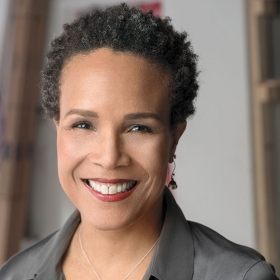Tracy Heather Strain ’82
From a brick-walled studio in Boston’s Fort Point Channel neighborhood, Tracy Heather Strain and her husband run their independent film company, the Film Posse.

Photo by Eric Levin
From a brick-walled studio in Boston’s Fort Point Channel neighborhood, Tracy Heather Strain and her husband, Randall MacLowry, run their independent film company, the Film Posse. On the first level, staffers peer into computer monitors, while on the second level, a stairway opens onto the couple’s modest living space.
Sitting on a futon sofa, Tracy answers questions about her latest film, the feature-length documentary, Lorraine Hansberry: Sighted Eyes/Feeling Heart, which was featured on PBS’s “American Masters” series in January. Tracy has been on the road, giving talks and screening the film, which has garnered wide acclaim. She says that it’s been a long process—14 years in fact—to bring this complicated woman to the screen.
Hansberry (1930–1965) is best known as the first African-American woman to have a play produced on Broadway, A Raisin in the Sun, its title taken from a Langston Hughes poem. The drama, starring a young Sidney Poitier, debuted in 1959, and it became a sensation. It was made into a movie in 1961. As a writer, intellectual, and civil rights activist, Hansberry’s star burned brightly during her life, which was cut short by cancer when she was 34 years old.
With the goal of eventually making a film about Hansberry, Tracy left advertising and embarked on the journey to realizing her dream. She first found work at a documentary film company that created science, nature, and technology programs. “I was just hungry to learn,” she says. “I was one of those people who learned how to put up lights and do that kind of stuff.”
Then in 1987, Tracy saw Eyes on the Prize, a six-part documentary on the American Civil Rights movement shown on PBS. It was a watershed event. “I realized I needed to learn how to make films like that,” she says.
After years of working on various media projects in other cities, it wasn’t until 1991 that she landed a job at Blackside Inc., the company that produced Eyes on the Prize. She began as an associate producer on the 1993 Great Depression series. “That was when I really started learning about storytelling,” Tracy says.
Tracy’s background as an American studies major at Wellesley played a role in her work. It was in college that she first realized that “you could look at a single event from a variety of viewpoints,” she says. The concept of multiple ways of viewing history stayed with her. “That’s what’s great about filmmaking, that you draw on all those kinds of things. You want to make a film that’s complex, and that works on a variety of levels,” she says.
Each project she worked on became the next stepping-stone toward her goal. One of her biggest obstacles was money: Securing grants is a perpetual challenge for independent filmmakers. So she was especially pleased when Wellesley classmates and alumnae contributed to the project.
The other difficulty was how to tell Hansberry’s story in a way that showed her complexity as a person. As Tracy studied Hansberry’s writings and absorbed the look and feel of the era in which Hansberry lived, the film began to take shape. Interviews with not only scholars but also with actors and friends such as Poitier, Ruby Dee, and Harry Belafonte added gravitas to the narrative.
Tracy says that while she’s gratified by the positive response to the film, she believes there’s more to say about Hansberry. Her goal now is to raise money for a series of video extras (which would include more than 30 interviews that didn’t make it into the final film) along with other materials that would bring Hansberry to a wider audience.


